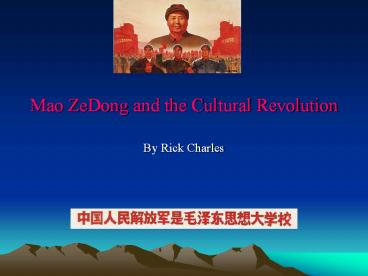Mao ZeDong and the Cultural Revolution - PowerPoint PPT Presentation
1 / 14
Title:
Mao ZeDong and the Cultural Revolution
Description:
The purpose is to destroy the pro-Communist China. The Great Leap Foward ... the turmoil of the 'Hundred Flowers' and 'Antirightist' campaigns of 1957. ... – PowerPoint PPT presentation
Number of Views:1437
Avg rating:3.0/5.0
Title: Mao ZeDong and the Cultural Revolution
1
Mao ZeDong and the Cultural Revolution
- By Rick Charles
2
- The Cultural Revolution was started in 1966 by
Chairman Mao Zedong it lasted for 10 years and
ended with Maos death in 1976. - As a child, Mao Zedong had a dream to become a
leader of his own country, China. - Although he was born into a poor family, it did
not prevent him from accomplishing his dreams. - Without his existence, there would not be a
People's Republic of China.
3
- In 1919, students, and intellectuals called for
China's modernization. - Mao published articles criticizing the
traditional value of Confucianism. - Professors at that time refused to acknowledge
his presence because he was poor and had no
status. - Because of the Marxian Socialism and the May 4th
Movement of students at Peking University, Mao
has been turned into a pro-revolutionary. - His early experience with China's bourgeois
intellectuals had left him with a residue of
destruction toward the purveyors of "book
learning."
4
- He later joined the Chinese Communist Party.
- After 7 years of controlling China, the KMT
(Kuomintang) and the CCP (Chinese Communist
Party), the 2 main parties in China began a civil
war. - The CCP won because it had a good army and great
support from the citizens and forced KMT's leader
Chiang Kai-Shek to flee to Taiwan. - Mao founded The People's Republic of China in
Beijing on October 10, 1949. He created the
Cultural Revolution, an idea that he designed
himself. The purpose is to destroy the
pro-Communist China
5
The Great Leap Foward
- Maos early experiences with peasant revolution
convinced him of the immense potential of peasant
strength. He believed that if properly organized
and inspired, the Chinese masses could accomplish
amazing feats. - Beginning in the mid-1950s Mao advocated the
rapid formation of agricultural communes, arguing
that the energy of the people could help China
achieve a high tide of Communist development. - This ideology exploded in the Great Leap Forward
in 1958. Mao called upon all Chinese to engage in
zealous physical labor to transform the economy
and overtake the West in industrial and
agricultural production within a few years. - Afraid to disappoint their leaders, peasants
falsified grain production numbers. - Several poor harvests caused massive famine and
the deaths of millions of people throughout China.
6
- Maos policies in the Great Leap Foward had
failed, but those in the government who
criticized him directly, such as Peng Dehuai,
were humiliated and purged from office. - Criticism of Mao from outside the government was
also muted because the educated elite remembered
the turmoil of the Hundred Flowers and
Antirightist campaigns of 1957. - Maos relationship with intellectuals was an
uneasy one, and he was critical of the gap
between the lives of the urban educated elite and
the rural masses. - These tensions were among the underlying causes
of the Cultural Revolution
7
The main ideas
- The main idea behind the cultural revolution was
to get everyone in China living at the same level
of wealth. - Another aim of the Cultural Revolution was to
stop the growth of Soviet Communism.
8
(No Transcript)
9
The four olds
- One of the ways to approach this is to rid every
one of their valuable possessions. - Maos red guards
would raid -
houses looking -
for four olds.
A four old is an item or behavior that shows old
custom, old culture, old habit, or old
ideas. Remember that while Mao was draining the
people in China of their wealth and power, Mao
was a very wealthy man himself.
10
this is a poster showing the red guards
raiding houses
11
Education
- Not with Mao around!
- Mao told the people of China that teachers were
against the revolution and that children
shouldnt continue their classes. - This left the children with free time since they
didnt go to classes. Mao encouraged them to
become red guards. - If you were chosen at a red guard audition it was
considered a great honor and was many childrens
dream.
12
Climax
- The cultural revolution brought about chaos as
the red guards went about destroying temples,
artwork, books, and anything that resembled a
four old. - Thousands of people died either of suicide or of
torture from the red guards. - People now despised Mao. This was completely
opposite from 10 years ago.
13
And in the end
- In 1976 Maos death brought about the end of
the revolution. China got a new leader and the
people of the country began to build back the
ruins and monuments that were destroyed in - the cultural revolution.
14
Bibliography
- The Cultural Revolution, Four Olds.
www.en.wikipedia.org - The Cultural Revolution. www.library.thinkquest.or
g The cultural revolution. www.fortunecity.com - Posters of the cultural revolution.
www.kaladarshan.arts.ohio-state.edu The PLA and
the - Cultural Revolution. www.iisg.nl Cultural
revolution. www.encarta.msn.com































